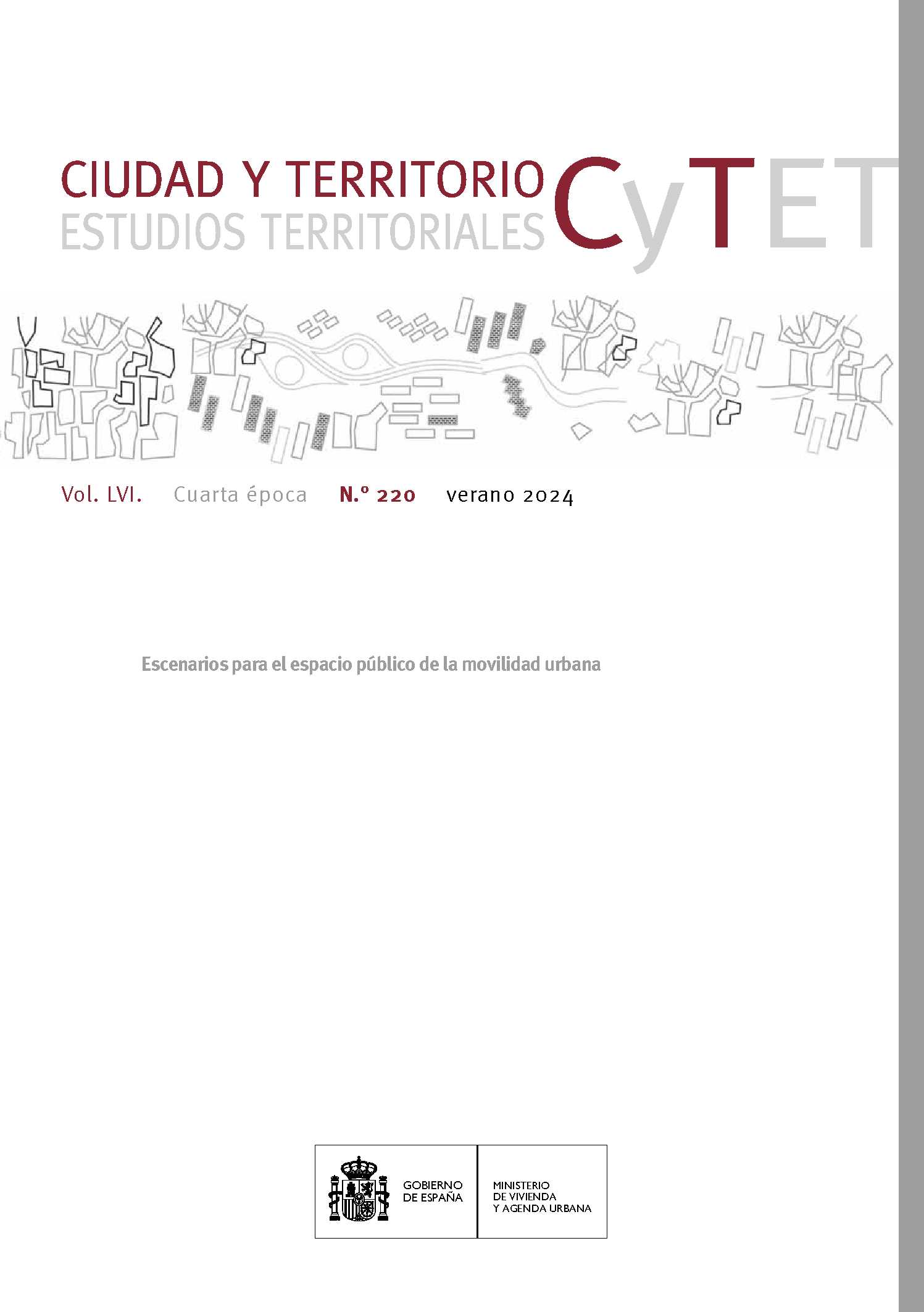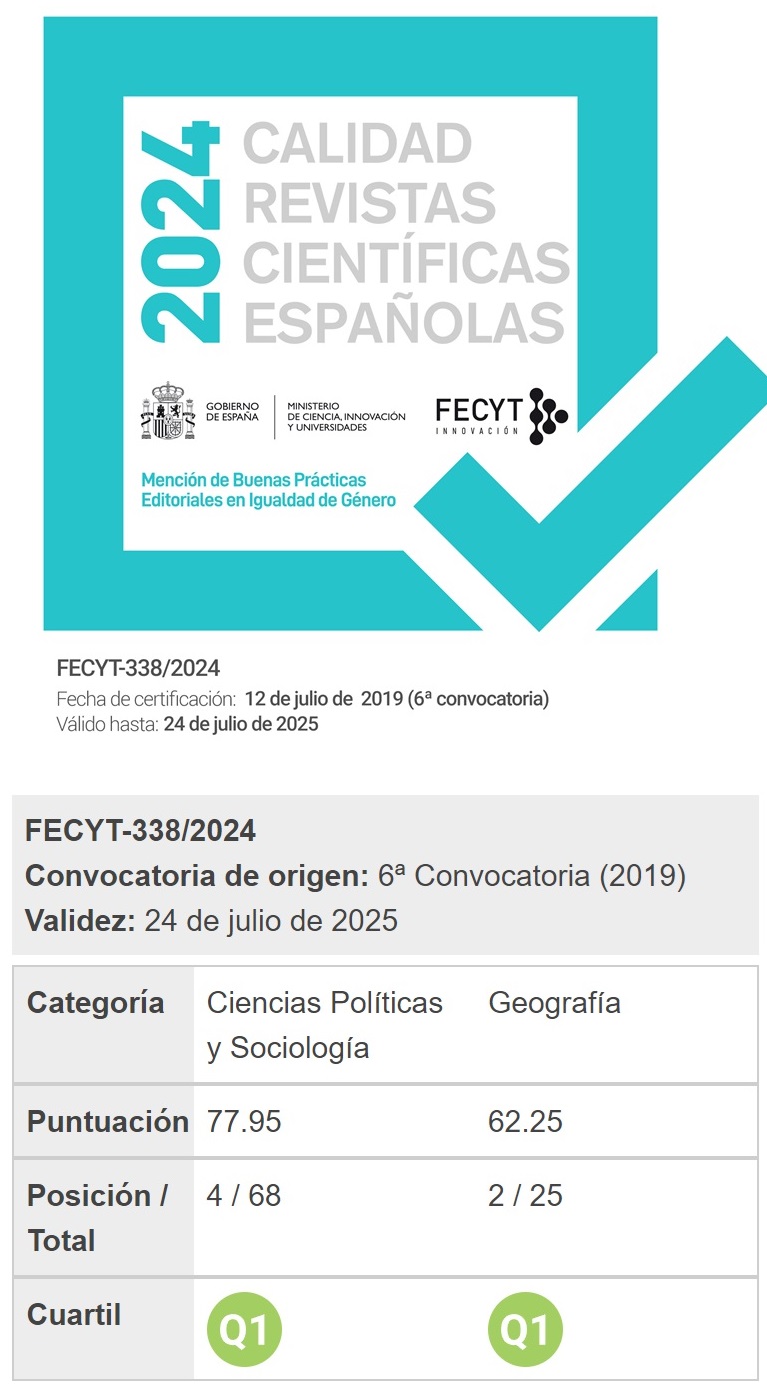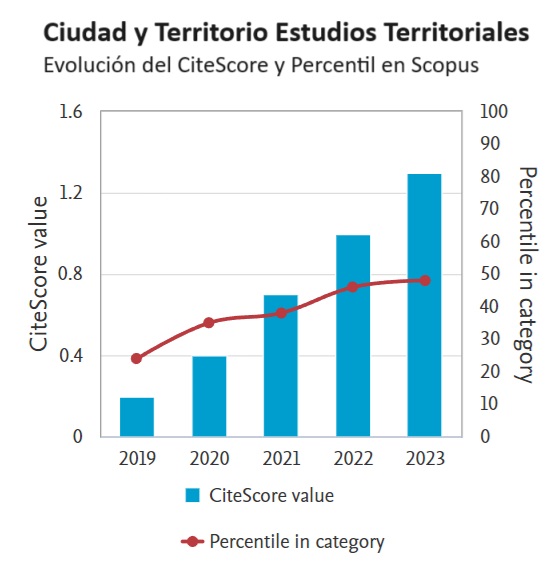Accesibilidad de proximidad y envejecimiento demográfico: desafíos para la adaptación de los espacios de la movilidad
DOI:
https://doi.org/10.37230/CyTET.2024.220.3Palabras clave:
Accesibilidad de proximidad, Movilidad, Envejecimiento demográfico, Personas mayoresResumen
El trabajo examina la relación entre entorno construido y accesibilidad de proximidad, analizando las características de los barrios de Santiago de Chile en donde se concentran los mayores porcentajes de personas mayores. Analizando antigüedad, densidad y tipologías de vivienda, el trabajo identifica ocho categorías de barrios que envejecen, diferentemente distribuidas a lo largo de un anillo que rodea el centro de la ciudad de Santiago. No se evidencia una clara relación entre tipologías de barrios y proximidad, siendo diferentes los patrones de accesibilidad a oportunidades urbanas. Al identificar tipologías prevalentes de barrios que envejecen, los resultados ofrecen indicaciones para adaptar las ciudades para las personas mayores y garantizar condiciones de vida más saludables.
Descargas
Citas
ACHARYA, S. & GHIMIRE, S. & JEFFERS, E. M. & SHRESTHA, N. (2019): Health Care Utilization and Health Care Expenditure of Nepali Older Adults. Frontiers in Public Health, 7, 24. https://doi.org/10.3389/fpubh.2019.00024
AKHAVAN, M. & VECCHIO, G. (2018): Mobility and Accessibility of the Ageing Society. Defining Profiles of the Elderly Population and Neighbourhood. Tema. Journal of Land Use, Mobility and Environment, 2, 9-22. https://doi.org/10.6092/1970-9870/5757
ANDREWS, G. J. & MILLIGAN, C. & PHILLIPS, D. R. & SKINNER, M. W. (2009): Geographical Gerontology: Mapping a Disciplinary Intersection. Geography Compass, 3(5), 1641-1659. https://doi.org/10.1111/j.1749-8198.2009.00270.x
ARELLANA, J. & SALTARÍN, M. & LARRAÑAGA, A. M. & ALVAREZ, V. & HENAO, C. A. (2020): Urban walkability considering pedestrians’ perceptions of the built environment: A 10-year review and a case study in a medium-sized city in Latin America. Transport Reviews, 40(2), 183-203. https://doi.org/10.1080/01441647.2019.1703842
BANISTER, D. & BOWLING, A. (2004): Quality of life for the elderly: The transport dimension. Transport Policy, 11(2), 105-115. https://doi.org/10.1016/S0967-070X(03)00052-0
BARRANCO-MARTÍN, M. DEL C. & CALONGE-REILLO, F. (2023): Accesibilidad de las personas mayores en entornos metropolitanos: conjunto de capacidades en el Área Metropolitana de Guadalajara (México). Ciudad y Territorio Estudios Territoriales, 55(218), 1107–1130. https://doi.org/10.37230/CyTET.2023.218.7
BOLDY, D. & GRENADE, L. & LEWIN, G. & KAROL, E. & BURTON, E. (2011): Older people’s decisions regarding ‘ageing in place’: A Western Australian case study. Australasian Journal on Ageing, 30(3), 136-142. https://doi.org/10.1111/j.1741-6612.2010.00469.x
BUTCHER, E. & BREHENY, M. (2016): Dependence on place: A source of autonomy in later life for older Māori. Journal of Aging Studies, 37, 48-58. https://doi.org/10.1016/j.jaging.2016.02.004
Corporación Andina de Fomento, CAF. (2017): Crecimiento urbano y acceso a oportunidades: Un desafío para América Latina. Corporación Andina de Fomento.
CHENG, L. & CASET, F. & DE VOS, J. & DERUDDER, B. & WITLOX, F. (2019): Investigating walking accessibility to recreational amenities for elderly people in Nanjing, China. Transportation Research Part D: Transport and Environment, 76, 85-99. https://doi.org/10.1016/j.trd.2019.09.019
CHUI, E. (2008): Introduction to Special Issue on ‘Ageing in Place’. Ageing International, 32(3), 165-166. https://doi.org/10.1007/s12126-008-9016-1
COSTA-FONT, J. & ELVIRA, D. & MASCARILLA-MIRÓ, O. (2009): `Ageing in Place’? Exploring Elderly People’s Housing Preferencs in Spain. Urban Studies, 46(2), 295-316. https://doi.org/10.1177/0042098008099356
CRUZ-MUÑOZ, F. (2021): Patrones de expansión urbana de las megaurbes latinoamericanas en el nuevo milenio. EURE (Santiago), 47(140), 29-49.
DOBNER, S. & MUSTERD, S. & DROOGLEEVER FORTUIJN, J. (2016): ‘Ageing in place’: Experiences of older adults in Amsterdam and Portland. GeoJournal, 81(2), 197-209. https://doi.org/10.1007/s10708-014-9613-3
FIGUEROA-MARTÍNEZ, C. (2023): Entre lo social y lo construido: comprendiendo la caminata en barrios vulnerables de Santiago. Revista De Urbanismo, (49), 21–41. https://doi.org/10.5354/0717-5051.2023.69411
FIGUEROA-MARTÍNEZ, C. & FORRAY, R. (2015): Movilidad femenina: Los reveses de la utopía socio-espacial en las poblaciones de Santiago de Chile. Revista de Estudios Sociales, 54, 52-67. https://doi.org/10.7440/res54.2015.04
FUENTES ARCE, L. & RAMÍREZ, M. I. & RODRÍGUEZ, S. & SEÑORET, A. (2023): Socio-spatial differentiation in a Latin American metropolis: urban structure, residential mobility, and real estate in the high-income cone of Santiago de Chile. International Journal of Urban Sciences, 27(2), 195-214.
GUZMÁN BRAVO, M. H. F. & OCHOA DE LA TORRE, J. M. (2014): Confort Térmico en los Espacios Públicos Urbanos, Clima cálido y frío semi-seco. Hábitat Sustentable, 52-63.
HAN, J. H. & KIM, J.-H. (2017): Variations in Ageing in Home and Ageing in Neighbourhood. Australian Geographer, 48(2), 255-272. https://doi.org/10.1080/00049182.2016.1240021
HE, S. Y. & CHEUNG, Y. H. Y. & TAO, S. (2018): Travel mobility and social participation among older people in a transit metropolis: A socio-spatial-temporal perspective. Transportation Research Part A: Policy and Practice, 118, 608-626. https://doi.org/10.1016/j.tra.2018.09.006
HERRMANN-LUNECKE, M. G. & FIGUEROA-MARTÍNEZ, C. & PARRA HUERTA, F. & MORA, R. (2022): The Disabling City: Older Persons Walking in Central Neighbourhoods of Santiago de Chile. Sustainability, 14(17), Article 17. https://doi.org/10.3390/su141711085
HERRMANN-LUNECKE, M. G. & MORA, R. & VÉJARES, P. (2020): Identificación de elementos del paisaje urbano que fomentan la caminata en Santiago. Revista de Urbanismo, 43, 4-25. https://doi.org/10.5354/0717-5051.2020.55975
HIRAI, T. (2022): “Double Ageing” in the High-Rise Residential Buildings of Tokyo. Urban Planning, 7(4), 313-324.
Instituto Nacional de Estadística, INE. (2023): Sistema de Indicadores y Estándares de Desarrollo Urbano. Default. http://www.ine.gob.cl/herramientas/portal-de-mapas/siedu
JACOBS-CRISIONI, C. & RIETVELD, P. & KOOMEN, E. & TRANOS, E. (2014): Evaluating the Impact of Land-Use Density and Mix on Spatiotemporal Urban Activity Patterns: An Exploratory Study Using Mobile Phone Data. Environment and Planning A: Economy and Space, 46(11), 2769-2785. https://doi.org/10.1068/a130309p
KACZYNSKI, A. T. & GLOVER, T. D. (2012): Talking the talk, walking the walk: Examining the effect of neighbourhood walkability and social connectedness on physical activity. Journal of Public Health, 34(3), 382-389. https://doi.org/10.1093/pubmed/fds011
KAN, H. Y. & FORSYTH, A. & MOLINSKY, J. (2020): Measuring the Built Environment for Aging in Place: A Review of Neighborhood Audit Tools. Journal of Planning Literature, 35(2), 180-194. https://doi.org/10.1177/0885412220903497
LEBRUSÁN, I. (2022): Personas mayores en situación de riesgo residencial extremo en España: un diagnóstico regional. EURE (Santiago), 48(145), 1-24.
LINK, F. & SEÑORET, A. & FIGUEROA MARTÍNEZ, C. (2022): Del barrio al conjunto: Espacio público y sociabilidad en la vivienda social de Santiago. Revista INVI, 37(106), 49-72.
LIU, S. & YAMAMOTO, T. & YAO, E. & NAKAMURA, T. (2021): Examining public transport usage by older adults with smart card data: A longitudinal study in Japan. Journal of Transport Geography, 93, 103046. https://doi.org/10.1016/j.jtrangeo.2021.103046
LOO, B. P. & LAM, W. W. Y. (2012): Geographic Accessibility around Health Care Facilities for Elderly Residents in Hong Kong: A Microscale Walkability Assessment. Environment and Planning B: Planning and Design, 39(4), 629-646. https://doi.org/10.1068/b36146
LOO, B. P. & MAHENDRAN, R. & KATAGIRI, K. & LAM, W. W. (2017): Walking, neighbourhood environment and quality of life among older people. Current Opinion in Environmental Sustainability, 25, 8-13. https://doi.org/10.1016/j.cosust.2017.02.005
LUCAS, K. & VAN WEE, B. & MAAT, K. (2016): A method to evaluate equitable accessibility: Combining ethical theories and accessibility-based approaches. Transportation, 43(3), 473-490. https://doi.org/10.1007/s11116-015-9585-2
MARIOTTI, I. & BURLANDO, C. & LANDI, S. (2021): Is Local Public Transport unsuitable for elderly? Exploring the cases of two Italian cities. Research in Transportation Business & Management, 100643. https://doi.org/10.1016/j.rtbm.2021.100643
MARTENS, K. (2017): Transport Justice: Designing Fair Transportation Systems. Routledge.
NATIONAL INSTITUTE ON AGING. (2017): Aging in Place. https://www.nia.nih.gov/health/topics/aging-place
NIU, J. & XIONG, J. & QIN, H. & HU, J. & DENG, J. & HAN, G. & YAN, J. (2022): Influence of thermal comfort of green spaces on physical activity: Empirical study in an urban park in Chongqing, China. Building and Environment, 219, 109168. https://doi.org/10.1016/j.buildenv.2022.109168
NORDBAKKE, S. (2013): Capabilities for mobility among urban older women: Barriers, strategies and options. Journal of Transport Geography, 26, 166-174. https://doi.org/10.1016/j.jtrangeo.2012.10.003
NORDBAKKE, S. & SCHWANEN, T. (2014): Well-being and Mobility: A Theoretical Framework and Literature Review Focusing on Older People. Mobilities, 9(1), 104-119. https://doi.org/10.1080/17450101.2013.784542
ORELLANA, D. & HERMIDA, C. & HERMIDA, M. A. (2022): ¿ Cerca o lejos? Discursos y subjetividad en las relaciones entre el lugar de residencia y la movilidad. EURE (Santiago), 48(144), 1-24.
PANI-HARREMAN, K. E. & BOURS, G. J. J. W. & ZANDER, I. & KEMPEN, G. I. J. M. & DUREN, J. M. A. VAN. (2020): Definitions, key themes and aspects of ‘ageing in place’: A scoping review. Ageing & Society, 1-34. https://doi.org/10.1017/S0144686X20000094
PLOUFFE, L. & KALACHE, A. (2010): Towards Global Age-Friendly Cities: Determining Urban Features that Promote Active Aging. Journal of Urban Health, 87(5), 733-739. https://doi.org/10.1007/s11524-010-9466-0
PUCCI, P. & VECCHIO, G. & GALLEGO VEGA, E. A. (2023): Women’s mobilities and perceived safety: Urban form matters. Evidence from three peripheral districts in the city of Bogotá. Journal of Urbanism: International Research on Placemaking and Urban Sustainability, 16(3), 310-340. https://doi.org/10.1080/17549175.2021.1987300
RODRÍGUEZ, D. A. & EVENSON, K. R. & DIEZ ROUX, A. V. & BRINES, S. J. (2009): Land Use, Residential Density, and Walking: The Multi-Ethnic Study of Atherosclerosis. American Journal of Preventive Medicine, 37(5), 397-404. https://doi.org/10.1016/j.amepre.2009.07.008
ROJAS, M. & ALDUNCE, P. & FARÍAS, L. & GONZÁLEZ, H. & MARQUET, P. A. & MUÑOZ, J. C. & PALMA-BEHNKE, R. & STEHR, A. & VICUÑA, S. (Eds.). (2019): Evidencia científica y cambio climático en Chile. Comité Científico COP25; Ministerio de Ciencia, Tecnología, Conocimiento e Innovación.
SÁNCHEZ-GONZÁLEZ, D. & RODRÍGUEZ-RODRÍGUEZ, V. (2016): Environmental Gerontology in Europe and Latin America. Policies and Perspectives on Environment and Aging. Springer.
SARRICOLEA, P. & SMITH, P. & ROMERO-ARAVENA, H. & SERRANO-NOTIVOLI, R. & FUENTEALBA, M. & MESEGUER-RUIZ, O. (2022): Socioeconomic inequalities and the surface heat island distribution in Santiago, Chile. Science of The Total Environment, 832, 155152. https://doi.org/10.1016/j.scitotenv.2022.155152
SCHWANEN, T. & HARDILL, I. & LUCAS, S. (2012): Spatialities of ageing: The co-construction and co-evolution of old age and space. Geoforum, 43(6), 1291-1295. https://doi.org/10.1016/j.geoforum.2012.07.002
SEONG, E. Y. & LEE, N. H. & CHOI, C. G. (2021): Relationship between Land Use Mix and Walking Choice in High-Density Cities: A Review of Walking in Seoul, South Korea. Sustainability, 13(2), Article 2. https://doi.org/10.3390/su13020810
SKINNER, M. W. & ANDREWS, G. J. & CUTCHIN, M. P. (Eds). (2018): Geographical Gerontology: Perspectives, Concepts, Approaches. Routledge. https://www.routledge.com/Geographical-Gerontology-Perspectives-Concepts-Approaches/Skinner-Andrews-Cutchin/p/book/9780367885564
STEINIGER, S. & FUENTES, C. & FLORES, D. & CASTILLO, B. & VECCHIO, G. & WALKER, J. & CARRASCO, J. A. (2022): STRIDE - una aplicación Android para recolectar experiencias de peatones para apoyar a las intervenciones con un foco en la caminabilidad. Estudios de Transporte, 23(2), Article 2.
STEINIGER, S. & ROJAS, C. & VECCHIO, G. (2019): Evaluating walkability with WalkMyPlace—Five reasons why the utility of Walkscore.com may be limited in South America. En P. Kyriakidis, D. Hadjimitsis, D. Skarlatos, & A. Mansourian (Eds.), Accepted Short Papers and Posters from the 22nd AGILE Conference on Geo-information Science. Cyprus University of Technology 17-20 June 2019. Stichting AGILE.
STJERNBORG, V. & WRETSTRAND, A. & TESFAHUNEY, M. (2015): Everyday Life Mobilities of Older Persons–A Case Study of Ageing in a Suburban Landscape in Sweden. Mobilities, 10(3), 383-401. https://doi.org/10.1080/17450101.2013.874836
TAKANO, T. & NAKAMURA, K. & WATANABE, M. (2002): Urban residential environments and senior citizens’ longevity in megacity areas: The importance of walkable green spaces. Journal of Epidemiology & Community Health, 56(12), 913-918. https://doi.org/10.1136/jech.56.12.913
TIZNADO-AITKEN, I. & MUÑOZ, J. C. & HURTUBIA, R. (2018): The Role of Accessibility to Public Transport and Quality of Walking Environment on Urban Equity: The Case of Santiago de Chile. Transportation Research Record, 2672(35), 129-138. https://doi.org/10.1177/0361198118782036
ULLOA-LEON, F. & CORREA-PARRA, J. & VERGARA-PERUCICH, F. & CANCINO-CONTRERAS, F. & AGUIRRE-NUÑEZ, C. (2023): “15-Minute City” and Elderly People: Thinking about Healthy Cities. Smart Cities, 6(2), Article 2. https://doi.org/10.3390/smartcities6020050
UNITED NATIONS. (2017): World Population Prospects: The 2017 Revision, Volume II: Demographic Profiles. United Nations.
UNITED NATIONS. (2019): World Population Prospects: The 2019 Revision, Volume II: Demographic Profiles. United Nations.
VAN DEN BERG, P. & ARENTZE, T. & TIMMERMANS, H. (2011): Estimating social travel demand of senior citizens in the Netherlands. Journal of Transport Geography, 19(2), 323-331. https://doi.org/10.1016/j.jtrangeo.2010.03.018
VECCHIO, G. & CASTILLO, B. & STEINIGER, S. (2020): Movilidad urbana y personas mayores en Santiago de Chile: el valor de integrar métodos de análisis, un estudio en el barrio San Eugenio. Revista de urbanismo, (43), 26-45.
VECCHIO, G. & MARTENS, K. (2021): Accessibility and the Capabilities Approach: A review of the literature and proposal for conceptual advancements. Transport Reviews, 41(6), 833-854. https://doi.org/10.1080/01441647.2021.1931551
VECCHIO, G. & TIZNADO-AITKEN, I. & CASTILLO, B. & STEINIGER, S. (2022): Fair transport policies for older people: Accessibility and affordability of public transport in Santiago, Chile. Transportation. https://doi.org/10.1007/s11116-022-10346-0
VECCHIO, G. & TIZNADO-AITKEN, I. & HURTUBIA, R. (2020): Transport and equity in Latin America: A critical review of socially oriented accessibility assessments. Transport Reviews, 40(3), 354-381. https://doi.org/10.1080/01441647.2020.1711828
VERGARA-PERUCICH, F. & BOANO, C. (2021): The big bang of neoliberal urbanism: The Gigantomachy of Santiago’s urban development. Environment and Planning C: Politics and Space, 39(1), 184-203. https://doi.org/10.1177/2399654420946759
VICUÑA DEL RÍO, M. (2015): Las formas de la densidad residencial: El caso del Gran Santiago, Chile. https://doi.org/10.7764/tesisUC/ARQ/16737
VICUÑA DEL RÍO, M & ELINBAUM, P., & VALENZUELA, L. M. (Eds.). (2022): Planes metropolitanos en Iberoamérica. Culturas e instrumentos. RIL editores.
WILES, J. L. & LEIBING, A. & GUBERMAN, N. & REEVE, J. & ALLEN, R. E. S. (2012): The Meaning of “Aging in Place” to Older People. The Gerontologist, 52(3), 357-366. https://doi.org/10.1093/geront/gnr098
WORLD HEALTH ORGANIZATION. (2009): Checklist of essential features of age-friendly cities. https://www.who.int/ageing/publications/Age_friendly_cities_checklist.pdf
WORLD HEALTH ORGANIZATION. (2018): Understanding «ageing in place». WHO Regional Office for the Western Pacific. https://iris.wpro.who.int/handle/10665.1/14008
Publicado
Cómo citar
Número
Sección
Licencia
Derechos de autor 2024 Giovanni Vecchio, David Cantallopts

Esta obra está bajo una licencia internacional Creative Commons Atribución-NoComercial-SinDerivadas 4.0.
Sin perjuicio de lo dispuesto en la legislación vigente sobre Propiedad Intelectual, y conforme a la misma, el/la los/las autor/a/es/as que publiquen en CyTET cede/n a título gratuito, de modo no exclusivo y sin límite temporal al Ministerio de Transportes, Movilidad y Agenda Urbana los derechos para difundir, reproducir, comunicar y distribuir en cualquier formato actual o futuro, en papel o electrónico, la versión original o derivada de su obra bajo licencia de Creative Commons Reconocimiento-NoComercial-SinObraDerivada 4.0 Internacional (CC BY-NC-ND 4.0), así como para incluir o ceder a terceros la inclusión de su contenido en índices, repositorios y bases de datos nacionales e internacionales, con referencia y reconocimiento en todo caso de la autoría del mismo.
Además, al realizar el envío, el/la los/las autor/a/es/as declara/n que se trata de un trabajo original en el que se reconocen las fuentes que han sido utilizadas en su estudio, comprometiéndose a respetar la evidencia científica y a no modificar los datos originales para verificar o refutar una hipótesis de partida; que el contenido esencial del mismo no ha sido publicado previamente ni se publicará en ninguna otra obra o revista mientras esté en proceso de evaluación en la revista CyTET; y que no se ha remitido simultáneamente a otra publicación.
Los autores deben firmar un Formulario de Cesión de Derechos, que les será enviado desde la Secretaría de CyTET una vez se acepte su artículo para ser publicado.
Con el objetivo de favorecer la difusión del conocimiento, CyTET se adhiere al movimiento de revistas de Open Access (OA) y entrega la totalidad de sus contenidos a diversos índices, repositorios y bases de datos nacionales e internacionales bajo este protocolo; por tanto, la remisión de un trabajo para ser publicado en la revista presupone la aceptación explícita por parte del autor/a de este método de distribución.
Se anima a las/os autoras/es a reproducir y alojar sus trabajos publicados en CyTET en repositorios institucionales, páginas web, etc. con la intención de contribuir a la mejora de la transferencia del conocimiento y de la citación de dichos trabajos.








 Enlace a CyTET en Linkedin
Enlace a CyTET en Linkedin